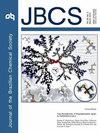MCM-22及其脱铝和脱层形式催化乙醇转化
IF 1.3
4区 化学
Q3 CHEMISTRY, MULTIDISCIPLINARY
引用次数: 0
摘要
在MCM-22沸石上研究了乙醇转化为碳氢化合物,特别是转化为轻烯烃的酸态(HMCM-22)和草酸脱铝(HMCM-22(OA))和分层(HITQ-2)得到的衍生态。草酸处理不影响沸石的结构性质,但降低了酸位的总密度和强度。在脱层过程中,HITQ-2沸石的比表面积、介孔体积和外孔面积最大,但微孔隙度不受影响。与前驱体HMCM-22相比,该样品的SiO2/Al2O3比较低,酸位密度最高,但以弱和中等强度酸位为主。脱铝处理和分层处理均导致样品中结构缺陷数量的增加。500℃下的催化性能比较表明,尽管样品的酸性和结构性质存在差异,但它们对乙醇转化具有活性,对乙烯生产具有高选择性。乙醇转化,其次是原位漫反射光谱(DRIFTS),也进行了研究。结果表明,两种样品在反应1 min后,“焦带”强度都已显著,与HMCM-22检测结果相似。本文章由计算机程序翻译,如有差异,请以英文原文为准。
Ethanol Conversion Catalyzed by MCM-22 and Its Dealuminated and Delaminated Forms
The conversion of ethanol into hydrocarbons, particularly into light olefins, was studied over MCM-22 zeolite in their acid form (HMCM-22) and its derived forms obtained by dealumination with oxalic acid (HMCM-22(OA)) and delamination (HITQ-2). The treatment with oxalic acid did not affect zeolite textural properties but reduced the total density and strength of the acid sites. As to the delamination process, HITQ-2 zeolite presented the highest Brunauer, Emmett and Teller (BET) specific area, mesopore volume, and external area, but the microporosity was not affected. This sample showed a lower SiO2/Al2O3 ratio than the precursor HMCM-22, resulting in the highest acid site density but with the predominance of acid sites with weak and intermediate strength. Both dealumination and delamination led to an increase in the number of structural defects in the samples. The comparison of the catalytic performance at 500 ºC showed that despite the differences in the acidic and textural properties of the samples, they were active for ethanol conversion and highly selective for ethylene production. Ethanol conversion, followed by in situ diffuse reflectance spectroscopy (DRIFTS), was also investigated. It showed that, for both samples, the “coke band” intensity was already significant after 1 min of reaction, similar to what was detected for HMCM-22.
求助全文
通过发布文献求助,成功后即可免费获取论文全文。
去求助
来源期刊
CiteScore
2.90
自引率
7.10%
发文量
99
审稿时长
3.4 months
期刊介绍:
The Journal of the Brazilian Chemical Society embraces all aspects of chemistry except education, philosophy and history of chemistry. It is a medium for reporting selected original and significant contributions to new chemical knowledge.

 求助内容:
求助内容: 应助结果提醒方式:
应助结果提醒方式:


